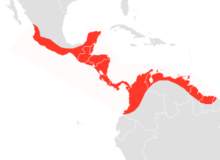Sinaloa velvet bat
| Sinaloa velvet bat | ||||||||||||
|---|---|---|---|---|---|---|---|---|---|---|---|---|
| Systematics | ||||||||||||
|
||||||||||||
| Scientific name | ||||||||||||
| Molossus sinaloae | ||||||||||||
| Allen , 1906 |
The Sinaloa velvet bat ( Molossus sinaloae ) is a species of bat from the family of bulldog bats (Molossidae), which is native to Central and South America. The species name "sinaloae" refers to the state of Sinaloa in Mexico, where the type was caught.
description
The Sinaloa velvet bat is a medium-sized bat with a head-to-body length of 120–140 mm and a wingspan of up to 33 cm. The weight averages 23–27 g, with the males being slightly larger and heavier than the females. However, there are also large geographic differences in size and weight. The fur of the Sinaloa velvet bat appears blackish, but the hair is two-colored, grayish at the base and dark brown to black at the tip.
Way of life
The Sinaloa velvet bat is a purely insectivorous bat that is found mainly in forests. Moths and other soft-bodied flying insects appear to be preferred prey, but beetles are not spurned either. The colonies can be found naturally during the day in crevices and caves as well as on palm fronds, but this species is also found very often in buildings. Colonies usually consist of more females than males. The males have a gland on their necks that produces a strong smelling, oily substance with which they mark their territory and their females. Females become sexually mature in their first year of life. The reproduction of Molossus sinaloae is seasonal and synchronized, with each female giving birth to a single cub each year. Only 5% of females give birth to twins.
distribution and habitat
The distribution of the Sinaloa velvet bat ranges from Mexico via Colombia , Venezuela , Suriname to French Guiana . Their populations are classified as stable and safe by the IUCN thanks to their widespread distribution and relative tolerance to man-made disturbance.
literature
- JB Jennings, TL Best, SE Burnett, JC Rainey: Molossus sinaloae , Mammalian Species , No. 691 (2002): pp. 1-5
swell
- ^ Theodor CH Cole: Dictionary of Mammal Names - Dictionary of Mammal Names . 1st edition. Springer-Verlag, Berlin Heidelberg 2015, ISBN 978-3-662-46269-0 .
- ↑ PD Heideman, KR Erickson, JB Bowles (1990): Notes on the breeding biology, gular gland and roost habits of Molossus sinaloae (Chiroptera, Molossidae). Journal of Mammals 55. pp. 303-307
- ↑ JB Bowles (1972): Notes on reproduction in four species of bats from Yucata'n, Mexico. Transactions of the Kansas Academy of Science 75. pp. 271-272
- ↑ Molossus sinaloae in the IUCN Red List of Threatened Species .
